Sacred Geometry
“When the ancients discovered ‘Phi’, they were certain they had stumbled across God’s building block for the world.”
― Dan Brown, The Da Vinci Code
Like numbers, Sacred Geometry is not an invention of Humankind. Geometric patterns are woven into the very fabric of Reality at every scale, and they were discovered by ancient civilizations independently all around the globe. As with Sacred Numerology, we can only begin to touch on this vast subject on this page. Our objective here is to show how Sacred Geometry — like Sacred Numerology — represents the nature of Reality at the highest levels of Abstraction, and to illustrate how it supports the only concept that is more Abstract; the Prime Duality: ISIT.
Point
Just as Reality begins with Absolute Infinite One, Sacred Geometry begins with the Point. The point is the quintessential representation of AIO. It occupies no time or space, and yet, every position in three-dimensional space is a point. It is at once nowhere and everywhere.
All geometric shapes ultimately reduce to points — an Infinite collection of points. And while we may identify the coordinates of a single point in space, the moment we define it we have reduced it to an Object. Those coordinates can never represent the true meaning of ‘the point’. The Point is eternally elusive. Absolutely Abstract. The Alpha and Omega. And all else derives from this singular point.
Line
The Line is the most elementary geometric concept in which the concept of The Other is introduced. A Point is the essence of Oneness, and is without dimension. With the Line, we suddenly have the concept of Object and Field. In order to discern a Line, we must discern that there is an area that is not that Line. The Line is the Object and the plane through which the line runs is the Field.
There are multiple points along a line. (Infinite, actually, but we’ll consider that ‘multiple’ for now). A Line is simply a series of points. There is nothing much new here. It is just endless repetition.
These are hallmarks of an ITistic Nature. Just as we saw with the Sacred Numerology, Sacred Geometry seems to oscillate back and forth between ISish to ITistic as it goes from Abstract to Derivative.
Here the pattern seems crystal clear: The Point is the Essence of AIO, and hence ISish. The Line is a reflective mirror of the Point that draws attention to the separation between IT and IS, a much more ITistic Object.
Curve

There are actually two types of Line: Straight and Curved. Think about it. That’s it. A straight line just keeps moving in the same direction, each point exactly following the one before it, with no deviation in the angle. A curved line has some kind of deviation built in so that each point is somehow just a little bit skewed from its neighbor point.
It’s actually quite odd to think about the difference between a straight and a curved line from the perspective of point-by-point. Ponder on that for a while.
Meanwhile, we can clearly see that the Curve swings the balance back over to the ISish side by injecting some Deviance into the straightforward form of the Line.
Circle
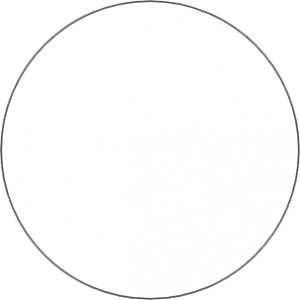
The curve returns to itself, becoming the Circle.
The Circle is a perfect representation of Absolute Infinite One. It is perfectly whole and complete. Not a single point on the circumference of a circle can possibly be the slightest bit out of alignment with any other point on that curve. The circle is, by definition, perfect.
The Circle has always been revered and held as a symbol of the Infinite long before mathematicians determined that Pi — the essence of the Circle — is an irrational number with an Infinite series of decimal points. Even now, with the power of our supercomputers we have managed to calculate the value of Pi to over 22 trillion decimals (and probably much higher by the time you read this), yet we are no closer to reaching the end of that than Archimedes was when he calculated it to three digits — 3.141. The fact that something so perfect can never be finally defined is a profound mystery that reveals the ultimate nature of Reality. Perfection can never be realized in this relative Universe. It is an Abstraction that belongs to the singular existence of the Absolute Infinite One.
The other fundamental shapes such as the triangle, square and all the rest ultimately derive from the circle, as we will soon see, just as all of the numbers derive from the number One and everything in Reality derives from the Absolute Infinite One.
Angle
The Angle Derives from the Circle. Two lines start at the center of the circle and extend outwards toward the perimeter, forming an angle. This is perhaps the single most elementary representation of the nature of reality next to the line itself as described above.

The point at the center of the circle represents Absolute Infinite One with two diverging lines is the simplest possible image of the moment of creation. Beginning at a single point, two lines diverge into an Infinite horizon. It is no doubt due to some innate response that this simple two-line form is so evocative to so many people, conjuring all kinds of Derivative images. What does this angle remind you of?
As the Angle represents The Other, Duality, divergence and separation, it is clearly an ITistic figure.
Just what is it that makes the Angle ITistic and the Curve ISish? If we zoom in closer and closer to the vertex of an angle and to the apex of a curve, it becomes more and more evident that the Angle and the Curve have a fundamental difference.
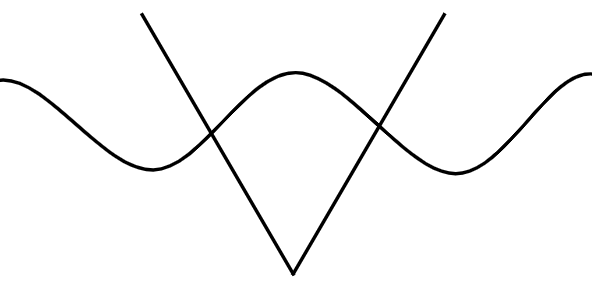
The Angle is two separate segments pointing in two distinctly different directions, with a crystal clear, definable point at which they meet/diverge. The Curve is a singular Object, with no particular point along the Curve that stands out from the rest. Curves flow in and around, through and between the rigid form of Angles, as Angles try to reinforce their structures against the wild, random ways of the Curve.
Triangle
The Triangle Derives from the Circle divided by angles, just as Reality derives from Absolute Infinite One divided by The Other. (Or is it the other way around?) While the triangle might appear at first glance to be the exact opposite of the circle, the fact that all of the angles of a triangle add up to 360° — just like a circle — shows that at a deeper level, the triangle is simply a derivative of the circle.
The sharp angles of the triangle certainly indicate it’s ITistic nature, but the odd number of angles and sides reveal the ISish essence.
Square
The square is the obvious next geometric shape in our oscillating progression, just as Four follows Three. There can be little doubt about the square’s orientation to IS and IT. Angular and even with four opposing sides, it is the quintessential symbol of IT. Even so, the four corners of the square still add up to 360°, and aligns perfectly with the circle, showing that derivative constructs reflect the essence of their source.
Platonic Solids
Plato was not the first person to become aware of the Platonic solids. In fact, there is evidence that these five elementary forms had been recognized thousands of years earlier. But it was Plato who brought them prominently to the consciousness of the Western World, recognizing the significance of these elementary geometric patterns in terms of how they form the basis of our entire reality.

Plato was fascinated by the concept of Forms — ultimate Abstractions that depicted the most perfect shape that Objects could take. The Platonic Solids were at the pinnacle of this Abstraction schema. They represent perfect symmetry and integration.
In terms of the ISIT Construct, their distinct definitions indicate their ITistic structure. Yet their perfection shows them to be IT in its original form — as close to ISish perfection as they can be. But while we do see the basic shape of Platonic Solids within ITistic Objects such as crystals, those perfect forms are elusive.
However, one emerging theory of quantum mechanics called “Emergence Theory” proposes that the the smallest Object upon which all Reality is based is a tetrahedron — the simplest of the Platonic Solids.
Vesica Piscis
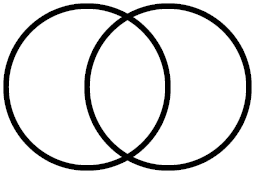 The Vesica Piscis is the most elegant and elementary representation of Duality. It depicts the split of AIO with its reflection. Just as AIO Engaged with the Other to create ISIT — something entirely new and original — the intersecting circles of the Vesica Piscis introduce something completely new — multi-dimensional angles.
The Vesica Piscis is the most elegant and elementary representation of Duality. It depicts the split of AIO with its reflection. Just as AIO Engaged with the Other to create ISIT — something entirely new and original — the intersecting circles of the Vesica Piscis introduce something completely new — multi-dimensional angles.
 All of the elementary shapes including triangles, equilateral and isosceles, rectangles, squares, hexagons, octagons; all the Platonic solids find their origin at the Vesica Piscis. The Vesica Piscis is the pivot point between the purely abstract point and circle, and the myriad combinations possible when lines and angles enter the picture.
All of the elementary shapes including triangles, equilateral and isosceles, rectangles, squares, hexagons, octagons; all the Platonic solids find their origin at the Vesica Piscis. The Vesica Piscis is the pivot point between the purely abstract point and circle, and the myriad combinations possible when lines and angles enter the picture.
Fruit of Life
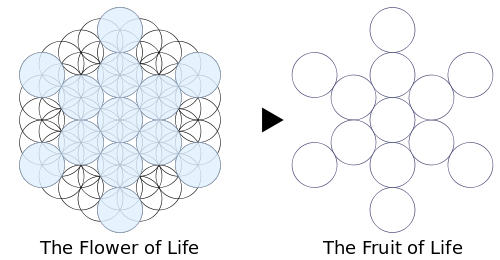 One of the most profound manifestations of Sacred Geometry is the Fruit of Life and its variations including the Seed of Life, the Tree of Life and Metatron’s Cube. These elegant patterns were identified before recorded history, and can be found carved into ancient temples all over the world.
One of the most profound manifestations of Sacred Geometry is the Fruit of Life and its variations including the Seed of Life, the Tree of Life and Metatron’s Cube. These elegant patterns were identified before recorded history, and can be found carved into ancient temples all over the world.
The following brilliant video by Spirit Science reveals how these patterns begin at the origin — a singular point expanding to a circle representing Absolute Infinite One. The addition of circles with their centers along the circumference of the original circle represents the Awareness of the concept of the Other, and introduces the element of Duality in the pattern.
 As the Seed of Life and Flower of Life fill out, more fundamental patterns emerge in the form of triangles representing the number 3 and the manifestation of ISIT — Creation itself.
As the Seed of Life and Flower of Life fill out, more fundamental patterns emerge in the form of triangles representing the number 3 and the manifestation of ISIT — Creation itself.
Finally, by connecting all the intersection points of the various circles (or spheres when considered from the three-dimensional perspective), we perceive the profound form of Metatron’s Cube emerge — based on the number 4 but containing all of the Platonic solids that form the basic building blocks of our Reality.
Waveforms

The standard curve is actually just a cross section or snapshot of another fundamental structure of Reality — the waveform. Electro-magnetism, gravity, radiation, all of these dynamic forces of the Universe vibrate with waveforms.
The waveform derives from the circle, as it is basically like a circle that has been turned inside out as described by the sine and cosine functions in trigonometry.
Standard Curve
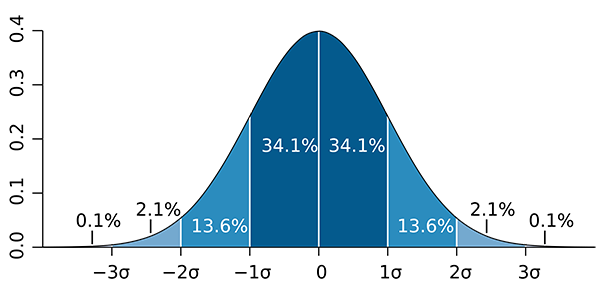
The standard curve is one of those patterns that are woven into the very fabric of Reality. It is so ubiquitous that most people take it for granted if they are aware of the concept at all. It applies to literally everything in this probabilistic universe.
The standard curve represents the distribution of Objects around a mean, or average value in a measurement of some attribute. For example, if we take the average height for every adult male in the United States we would have a list of millions of heights, with one average in the middle and the frequency of heights decreasing as we move to the extremes. This pattern applies whether we are talking about the height of people, the weight of pineapples, or the heat of stars.
There are Infinite standard curves, applying to every attribute of every object in Reality — a universal rule.
The waveform is a fundamental pattern that is built into our Reality from the ground up, describing everything at every scale.
And while the waveform is derivative of a circle, it is still an abstraction of a more derivative concept, the spiral.
Spirals

When we think of waveforms we tend to think of them as traveling in a single vertical plane, that is we see them oscillating up and down but not side to side. In fact, photons actually spiral through space, which makes sense in a three-dimensional space. Why would waveform oscillation be only two-dimensional?
 The spiral, therefore, is the next level of derivation from the standard curve and waveform. All throughout Reality, Objects are spiraling around each other, driven by a constant barrage of waveforms all following the law of the standard curve. So from electrons and photons spiraling through space to the dual helix of DNA to spiral galaxies, we see the spiral shape manifesting throughout reality.
The spiral, therefore, is the next level of derivation from the standard curve and waveform. All throughout Reality, Objects are spiraling around each other, driven by a constant barrage of waveforms all following the law of the standard curve. So from electrons and photons spiraling through space to the dual helix of DNA to spiral galaxies, we see the spiral shape manifesting throughout reality.
Like the Platonic Solids, the Spiral introduces the concept of the third dimension to its more abstract two-dimensional models: circles and cycles. Again, we see that increasing derivation means increasing complexity and more opportunities for still deeper derivation.
The Torus
The spiral can be a subset of another ubiquitous form that occurs throughout reality — the torus. The torus is basically a donut shape, with energy flowing around the donut, flowing up through the bottom of the hole in the middle and out and over the top. It is a self-contained spiral.
Phi: The Golden Ratio

The Golden Ratio, also known as the Golden Mean and other equally superlative names has been held in awe by educated people since antiquity. According to Wikipedia:
“Some of the greatest mathematical minds of all ages, from Pythagoras and Euclid in ancient Greece, through the medieval Italian mathematician Leonardo of Pisa and the Renaissance astronomer Johannes Kepler, to present-day scientific figures such as Oxford physicist Roger Penrose, have spent endless hours over this simple ratio and its properties. But the fascination with the Golden Ratio is not confined just to mathematicians. Biologists, artists, musicians, historians, architects, psychologists, and even mystics have pondered and debated the basis of its ubiquity and appeal. In fact, it is probably fair to say that the Golden Ratio has inspired thinkers of all disciplines like no other number in the history of mathematics.”
Fractal Patterns


